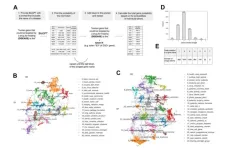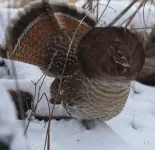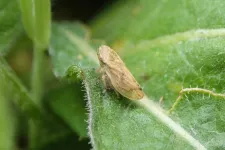(Press-News.org) Most Americans take it for granted that the water that comes out of their taps is clean and safe to drink.
But a new study published by a University of New Mexico scientist with colleagues from across the U.S. warns that water from many wells and community water systems contains unsafe levels of toxic contaminants, exposing millions to health risks, including cancer.
The review in the Journal of Exposure Science and Environmental Epidemiology also finds that people living on tribal lands or in minority communities are disproportionately affected and predicts that climate change will make it harder to locate safe sources of drinking water.
The paper emerged from a meeting of senior scientists at the annual meeting of the International Society for Exposure Epidemiology, said Johnnye Lewis, Ph.D., professor emerita in the Department of Pharmaceutical Sciences, multiple principal investigator of the Navajo Birth Cohort Study, co-director of Community Environmental Health Program and director of the UNM METALS Superfund Research Program.
“There were several of us that have expertise in dealing with these particular contaminants, and we were seeing that they’re not always at safe levels in drinking water sources for a number of reasons,” Lewis said.
The paper assesses seven known contaminants that often find their way into drinking water: arsenic, fracking fluids, lead, nitrates, chlorinated disinfection byproducts, manmade chemicals known as PFAS (per- and polyfluoroalkyl substances) and uranium. The ability to detect and remove these substances from drinking water varies widely.
Most of the substances, including inorganic arsenic, nitrates, uranium and lead, are known or suspected carcinogens, while chronic exposure to most of the contaminants has been linked to a host of other issues, including neurological and developmental problems.
“Some of these, like uranium and arsenic – and even nitrates – are just common,” Lewis said. “They commonly occur in groundwater, and sometimes it is the source that you have access to.”
Other contaminants, like fracking fluids and PFAS, are introduced by humans and represent uncharted risks.
For example, PFAS can linger in the environment for decades without degrading, a problem that hasn’t been addressed until recently. “I think there was concern, but it wasn’t at this scale and was elevated to where it is now,” she said. “It’s like much of what we do as a society. You take the action first and then down the road try to figure out how to fix it. That’s usually a bad strategy.”
The seven contaminants represent a small fraction of the thousands of the chemical agents present in drinking water, the authors report. And to complicate matters, two or more contaminants may be present in a water source, presenting the possibility of synergistic effects.
“We’re only really now starting to come up with good methods to assess what those mixtures do,” Lewis said. “There’s always a lot of uncertainty, because a mixture is not the same in one community as it is in the next.”
Larger water systems have the ability to remove or dilute the concentrations of some contaminants, but many Americans lack even that minimal protection.
The researchers estimate that there are about 150,000 public water systems in the U.S., about one-third of which are community water systems serving about 320 million Americans – 95% of the population. Ninety-one percent of the community water systems serve fewer than 10,000 people – covering 52 million in all, while more than 43 million Americans rely on private wells for drinking water.
The authors say their paper “highlights the need for a concerted effort to invest in upgrading our drinking water infrastructure, strengthen drinking water standards, develop and implement enhanced water treatment, collect and disseminate monitoring data, and require more stringent chemical safety testing.”
Lewis meanwhile cautions that climate change is making it harder to find clean sources of drinking water, particularly in the western U.S.
“For me the thing that is most concerning is that you start looking at drought and the stresses that that puts on looking for additional water sources,” she said. “The potential for making sure those sources are clean could become more limited.”
Climate change impacts will most severely affect those least able to cope, Lewis said, because there is little or no water monitoring in underserved areas. “When we talk about racial injustice and societal injustice in communities that are underserved, they’re the ones that are going to bear the brunt of this.”
END
U.S. drinking water often contains toxic contaminants, UNM scientist warns
2023-10-04
ELSE PRESS RELEASES FROM THIS DATE:
AI model for age-related disease target discovery
2023-10-04
“In this work, we focused on the application of the established pipeline to the identification of the potential targets related to aging [...]”
A new research paper was published in Aging (listed by MEDLINE/PubMed as "Aging (Albany NY)" and "Aging-US" by Web of Science) Volume 15, Issue 18, entitled, “Biomedical generative pre-trained based transformer language model for age-related disease target discovery.”
Target discovery is crucial for the development of innovative therapeutics and diagnostics. However, current approaches often face ...
Ruffed grouse population more resilient than expected, genetic study finds
2023-10-04
Despite decades of decline, a genetic analysis of ruffed grouse reveals that Pennsylvania’s state bird harbors more genetic diversity and connectivity than expected. The findings suggest that the iconic game bird could be maintained in persistent numbers if appropriate protections are implemented. The study, led by Penn State and Pennsylvania Game Commission researchers, published in the journal Molecular Ecology.
According to the researchers, Pennsylvania’s ruffed grouse populations have declined by up to 70% since the early ...
Ohio State awarded $20 million to put science behind tobacco product regulation
2023-10-04
The Ohio State University (OSU) has been awarded a $20 million Tobacco Center of Regulatory Science (TCORS) grant from the Food and Drug Administration’s (FDA) Center for Tobacco Products and National Institutes of Health.
The OSU-TCORS grant is a collaboration of experts from the colleges of medicine, public health and law organized and implemented through the Center for Tobacco Research at The Ohio State University Comprehensive Cancer Center – Arthur G. James Cancer Hospital and Richard J. Solove ...
Both high and low HDL cholesterol tied to increased risk of dementia
2023-10-04
EMBARGOED FOR RELEASE UNTIL 4 P.M. ET, WEDNESDAY, OCTOBER 4, 2023
MINNEAPOLIS – Having either high or low levels of high-density lipoprotein (HDL) cholesterol, or “good” cholesterol, is tied to a small increased risk of dementia in older adults, according to a study published in the October 4, 2023, online issue of Neurology®, the medical journal of the American Academy of Neurology. This study does not prove that high or low levels of HDL cholesterol cause dementia; it only shows an association.
“Previous studies on this topic have been ...
Meadow Spittlebug’s record-breaking diet also makes it top disease carrier for plants
2023-10-04
New research fueled in part by citizen scientists reveals that the meadow spittlebug—known for the foamy, spit-like urine released by its nymphs—can feed on at least 1,300 species of host plants, more than twice the number of any other insect.
The study, which is published today in the journal PLOS ONE, could be especially important in the effort to stop the bug from spreading a type of bacterium that has caused the death of crops across the world, including olive trees in Italy, grapevines in California, citrus trees in South America, and almond trees in Spain.
“Thirteen hundred host plants means 1,300 opportunities ...
Keshav Pingali to receive ACM-IEEE CS Ken Kennedy Award
2023-10-04
ACM, the Association for Computing Machinery, and IEEE Computer Society have named Keshav Pingali, the W.A.”Tex” Moncrief Chair of Grid and Distributed Computing at the University of Texas at Austin, as the recipient of the 2023 ACM-IEEE CS Ken Kennedy Award. The Ken Kennedy Award recognizes groundbreaking achievements in parallel and high performance computing. Pingali is cited for contributions to high-performance parallel computing for irregular algorithms such as graph algorithms. He is also cited for leadership on the Galois Project, which provides a unifying framework for parallelizing both irregular and regular algorithms.
Pingali has made deep and wide-ranging ...
Pandemic boosted gardening, hunting in NYS
2023-10-04
A survey of New York state residents found that nearly half of respondents increased the amount of time they spent on wild and backyard food in the early months of the COVID-19 pandemic, confirming anecdotes about increases in activities such as sourdough baking, fishing and gardening. People also tended to eat the food they produced, researchers found, possibly buffering the generally less healthful eating that was common at the time.
“This was the period of 2020 when you couldn't find tomato cages, seeds were out of stock, and there were reports about record numbers of people hunting and ...
Study identifies jet-stream pattern that locks in extreme winter cold, wet spells
2023-10-04
Winter is coming—eventually. And while the earth is warming, a new study suggests that the atmosphere is being pushed around in ways that cause long bouts of extreme winter cold or wet in some regions.
The study’s authors say they have identified giant meanders in the global jet stream that bring polar air southward, locking in frigid or wet conditions concurrently over much of North America and Europe, often for weeks at a time. Such weather waves, they say, have doubled in frequency since the 1960s. In just the last few years, they have killed hundreds of people and ...
Department of Defense grant awarded to study metastasis in bladder cancer
2023-10-04
A Weill Cornell Medicine researcher has received a $610,000 grant from the Department of Defense to investigate the mechanisms causing DNA instability that potentially drives metastasis in bladder cancer. The research also aims to identify methods to intercept this spread. The Peer-Reviewed Cancer Research Program (PRCRP) Idea Award funds innovative, high-risk, high-reward basic cancer research. One of the goals of the PRCRP program is to decrease the burden of cancer on service members and their families, veterans, and the American public.
“Approximately 40% of patients with muscle-invasive bladder cancer develop metastases, where ...
Simultaneous large wildfires will increase in Western U.S.
2023-10-04
Contacts:
David Hosansky, UCAR/NCAR Manager of Media Relations
hosansky@ucar.edu
720-470-2073
Audrey Merket, UCAR/NCAR Science Writer and Public Information Officer
amerket@ucar.edu
303-497-8293
Simultaneous outbreaks of large wildfires will become more frequent in the Western United States this century as the climate warms, putting major strains on efforts to fight fires, new research shows.
The new study, led by scientists at the National Center for Atmospheric Research (NCAR), focused on wildfires of 1,000 acres or larger. It found that wildfire seasons in which ...




